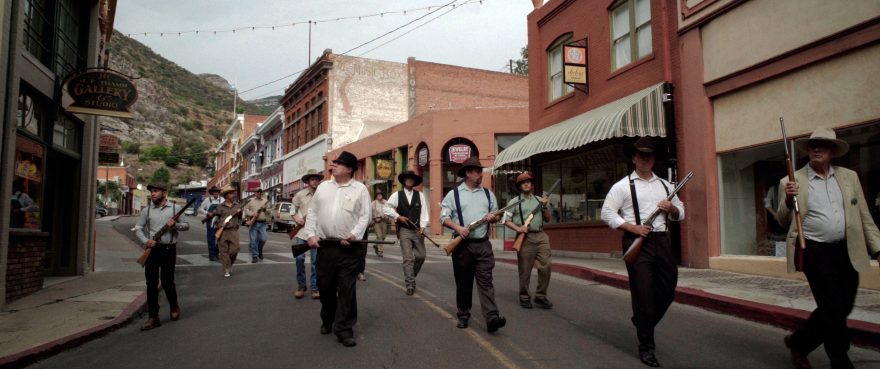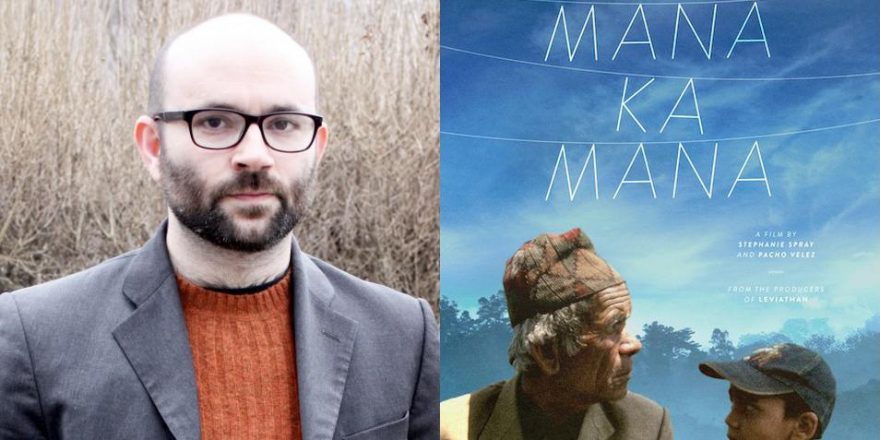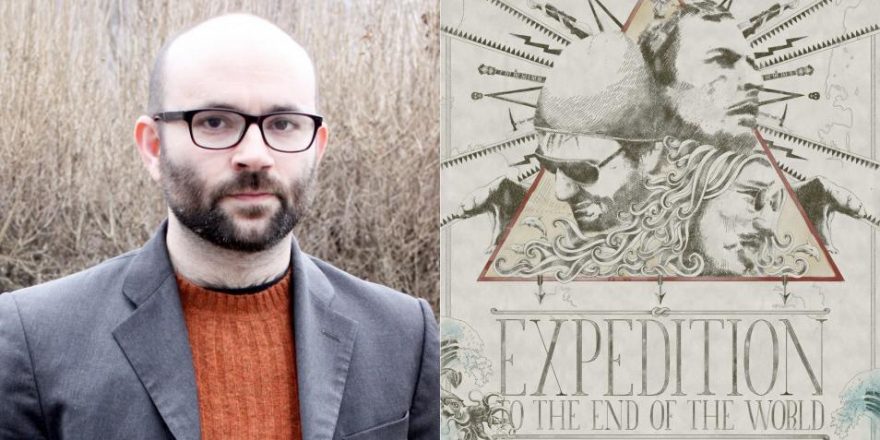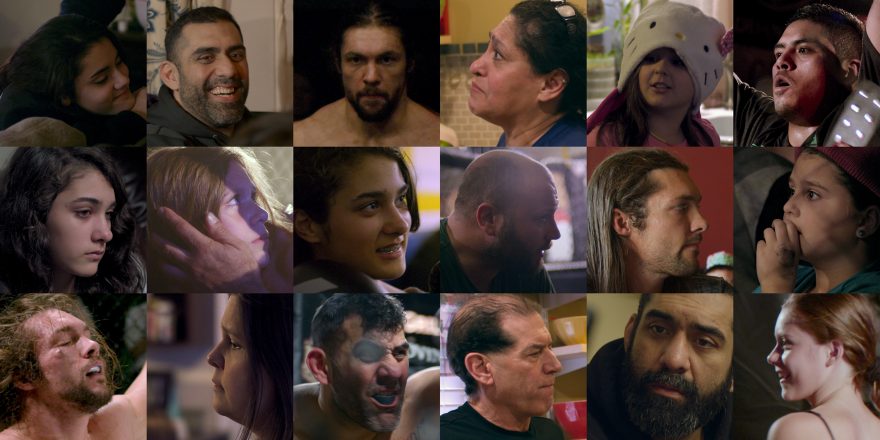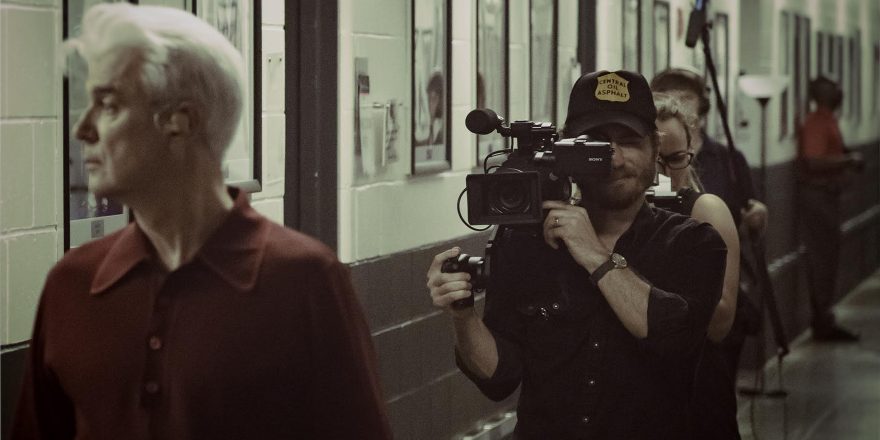“The ‘Frontier’ for them was a complexly resonant symbol, a vivid and memorable set of hero-tales – each a model of successful and morally justifiable action on the stage of historical conflict.” – Richard Slotkin, Gunfighter Nation: The Myth of the Frontier in Twentieth-Century America
Robert Greene (director): In the United States, we are all carriers of myth; we live, breathe and enact on a daily basis the layered fantasies of two Big American Ideas: domination and capital. A century ago, Bisbee, Arizona, was known as a “white man’s camp,” and the forced deportation of 1200 striking miners on July 12, 1917 was an atrocity built on ideologies embedded in our American fantasy. In Bisbee ’17, our goal was to use images from well-known genres to reveal how mythologies work on us today, and to expose these mythologies as performances that we can see through. The film follows members of Bisbee’s close-knit community as they confront their darkest day.
Jarred Alterman (director of photography): For the scene where the deputies march into town to arrest the strikers (above), I was thinking of the famous walk-into-battle sequence in Sam Peckinpah’s The Wild Bunch.
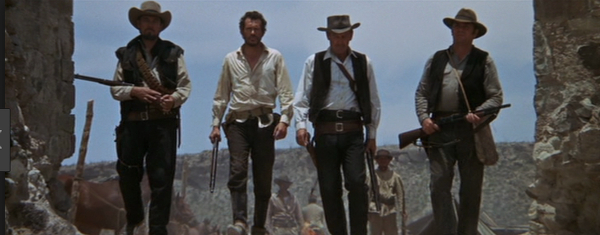
We were creating a visual language from different genres and styles, weaving together narrative and documentary. Widescreen Westerns, choreographed musical numbers, chaotic protests and intimate observational portraits. Bisbee was a 360-degree stage, its residents were our subjects and actors, our cameras instigating and investigating.
Susan Bedusa (producer): If any other director had come to me and pitched the idea of Bisbee ’17, a Western / musical / kinda-scripted-period-piece-present-tense-documentary, my head would likely have exploded. But having produced Robert’s work for close to 15 years, and seeing the evolution of his previous films, I trusted him to make this film.
Douglas Tirola (producer): I have been lucky enough to work with Robert and two of Bisbee‘s producers for more than a decade. I’ve learned that finding people you can work with for a long time is rare, so if you can create that environment, you grab whatever opportunity you can to hang onto it. As I like to say, I am more a Rolling Stones fan than a Beatles fan. The Stones have been together for more than 55 years.
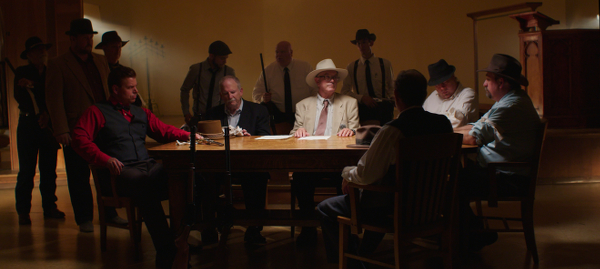
Greene: Sheriff Harry Wheeler was the man who deputized 2000 Bisbee residents to carry out the orders of the mining companies. For an Arizona Ranger who imagined himself to be a cowboy but had missed the glory days of the Wild West, this must have been a fantasy come true: to “save Bisbee” by detaining 2000 striking immigrant miners at gunpoint. Industrial Workers of the World (I.W.W.) union members were now the “bad guys,” and they needed to be rounded up and shipped out.
Alterman: In the frame above from the bosses meeting scene, all of the emphasis is on Wheeler. Its tone draws from the Western, where we often see staged wide shots of men making important decisions. For this shot, our positioning was everything; I considered how Sidney Lumet carefully arranged the puzzle pieces in Twelve Angry Men. We used theatrical stage blocking, placing actors unnaturally in a cinema-space, so the camera captures everyone at once.
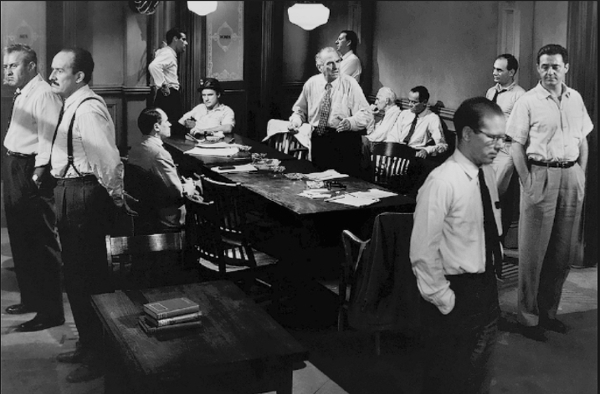
Bennett Elliott (producer): By the time we shot this scene, we already had a couple of staged scenes under our belt. However, this came at the end of an already incredibly ambitious day of filming. It took our entire crew and a handful of strangers to carry the conference table in for the scene. Nothing was working in our favor – we didn’t have enough period-specific guns, the smoke machines weren’t working properly, and our actors were starting to get tired. I ended up ordering a lot of pizzas, allowing plenty of smoke breaks, and wiping down a lot of sweaty foreheads.
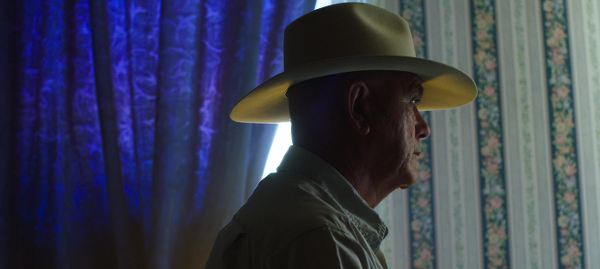
Greene: Richard Hodges, a lifelong Bisbee resident with family on both sides of the Deportation, played Sheriff Harry Wheeler. Richard is a plainspoken, thoughtful man who holds complex views about the event. We presented many of the main characters in the film as if they were acting in a particular genre. For Richard-as-Wheeler, it made sense that he was in his own Western. Wheeler was enacting the mythologies of the Wild West, and so was Richard: Good White Man with a Gun.
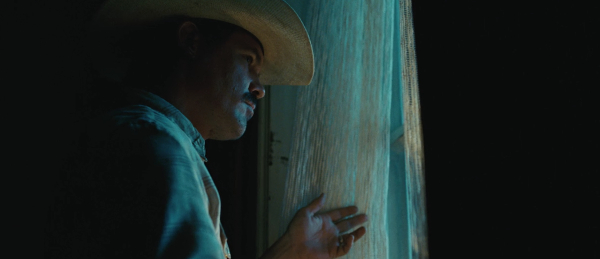
Alterman: For this scene, I was heavily influenced by how Roger Deakins used color and texture in the Coen brothers’ No Country for Old Men. Wheeler, like Josh Brolin’s Llewelyn Moss, is hiding, waiting in a hotel room, and the space takes on his emotional state. Here Wheeler is in shadow, with curtains closed, as he contemplates his next move.
Elliott: Robert, Jarred and I met Richard when we were scouting Bisbee High School for possible shooting locations and holding spaces for our biggest crowd scenes. I ended up talking to Richard, who told me anecdotes about growing up in Bisbee and his thoughts on the Deportation. At the time, Robert and I couldn’t find someone to play Wheeler; during lunch breaks, we would drive around town looking out the window, hoping to find the right person. After that initial meeting with Richard, something clicked. We pitched him the idea at the “bus barn” across from the high school. Richard was skeptical, but agreed to give it a go.
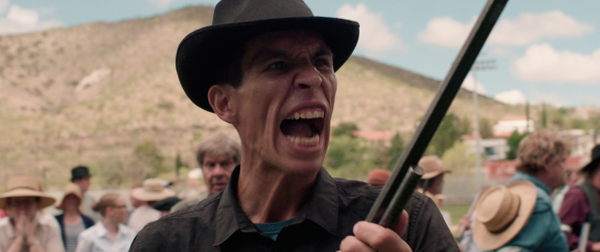
Bedusa: The stunning thing about the large-scale recreation scenes was that the people we’d been following all summer and the characters that they were portraying revealed themselves in a way that they hadn’t before. As soon as Robert yelled “Action,” the people whose stories we were telling, the ghosts of Bisbee, came to life right in front of our eyes.
Greene: Peter Watkins made films like Culloden, Punishment Park and La Commune which overtly collapsed realities and fictions. There were moments while shooting our reenactment of the round-up and deportation that I felt like I was inside a Watkins film. Conceptually, images that Watkins created were always important to what I wanted to do in Bisbee, but when people started enacting their own ideologies, outside of my direction, it felt like we had stumbled into our own Stanford Prison Experiment. Reality had become a movie I was no longer directing.
Alterman: What started out as a multi-camera shoot quickly morphed into living theater; subject-directed scenes spun off from the pack and we relied on our documentary instincts to tell the unfolding stories. We could start and stop the action, allowing the actors to warm up and give us moments, but their controlled chaos had a life-force of its own.
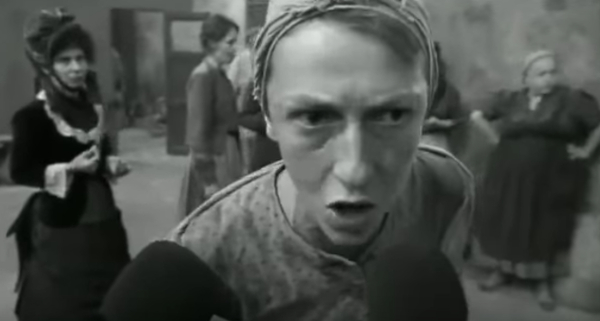
With this above frame from Peter Watkins’ La Commune, it’s hard to escape the tension. He brilliantly always keeps the energy contained within the frame and on Bisbee we often referred to this philosophy and approach.
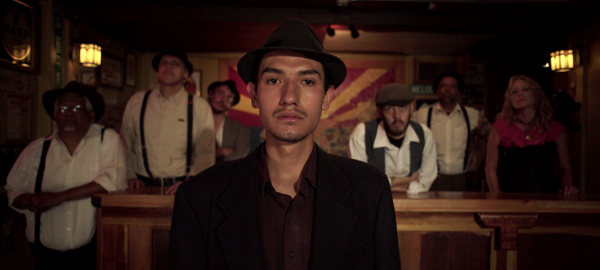
Greene: Fernando Serrano is young and fun loving, and his life is an adventure. We portrayed our Mexican-American hero like he was in a modern musical; this is a mode of storytelling where the latent desires of individuals manifest in exuberant formal flourishes, where the deeply internal becomes grandly, maximally external. Fernando is conflicted about his role in the reenactments and his turmoil – playing a ghost version of himself from 100 years ago – is transmitted through his relationship with the songs he sings.
Alterman: Before we landed in a music-video headspace for this scene, it started with our love for Herbert Ross’ Pennies From Heaven, where the actors suddenly break into song, overtly lip-syncing to older melodies.
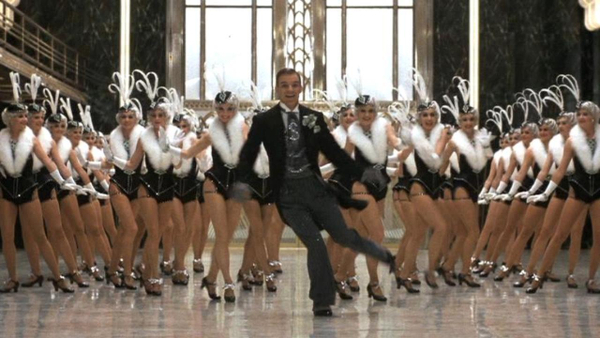
For the scene where Fernando transforms into his character, I love how it starts in classic Western form – a silhouette of a man who walks into a bar …
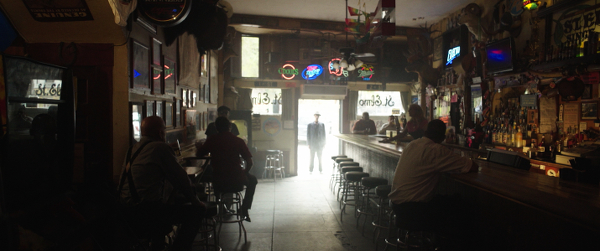
… but it quickly becomes a musical number. This was one take, so there was a lot of choreography both in front of and behind Fernando, since our background actors get up, change into miner clothes, and follow him.
Elliott: During our first trip to Bisbee in October 2016, we were given a headshot for Fernando, a young guy who worked at the local Vietnamese restaurant. As soon as I saw the picture, I knew Fernando was perfect. He had a magnetism and intensity that I knew would be reflected on screen. Robert was skeptical – he thought Fernando was too “pretty” to be a miner – but he quickly came around.
Greene: Fernando is undoubtedly a star … but what does that mean, exactly? It means that his natural good looks and charisma shine through and create an immediate emotional connection with the viewer. When you cast your film, you cast your fate, as the saying goes – and this might be especially true in documentary. The truth, however, is that Fernando was sometimes shy, sometimes conflicted and even a little bewildered by his own role in the film. His electric presence onscreen belies the ethical and downright existential questions his collaboration with us brought up. At what cost does one become radical?
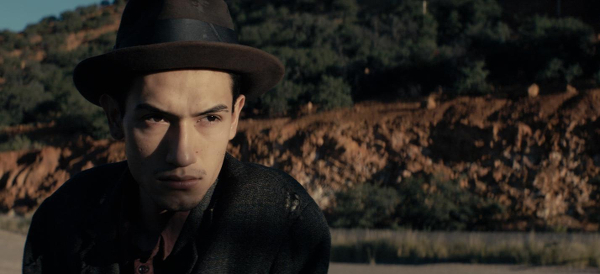
Alterman: For our screen test with Fernando, we walked down to the open pits but nothing was really clicking. Suddenly, the sun broke behind us, so I reversed the shot, placing him in a shaft of light, putting the emphasis on his hat and eyes, partially illuminating his shoulder and lips. Fernando transformed this experimental “test” into a meaningful moment. He had no lines, but his stare was everything. It was also funny to re-imagine this typical American Western image, where you’d normally see a white cowboy staring into the distance, with a Mexican-American actor, using Russian lenses. This was my first subversive act on Bisbee ’17.
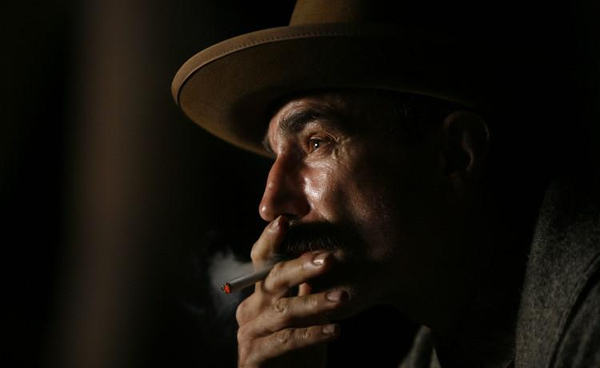
Paul Thomas Anderson’s There Will Be Blood was an important influence; not just the cinematography, but how picture, sound and costumes worked harmoniously in building the overall tone. This moody, angular profile of Daniel Plainview (Daniel Day-Lewis) feels part fashion photography, part Western. The image is stripped down to hand-cigarette-eyes-hat, as if lifted from a graphic novel.
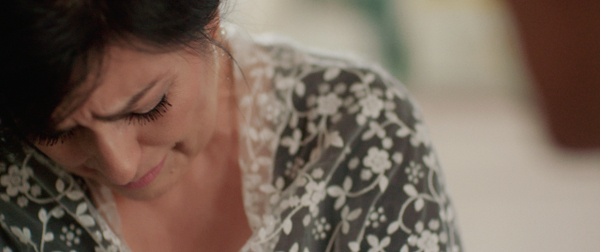
Greene: After her onscreen interview in the film, local politician Mary Ellen Suarez-Dunlap mentioned that her Mexican family often “dramatizes” their own lives, as many families do, just like in the telenovelas. When she said this, a lightbulb went off: we had just filmed a scene where Mary Ellen plays Fernando’s mother, urging him not to join the strike, and we had filmed it (and more crucially, Mary Ellen had played it) like a telenovela scene. She had self-selected this melodramatic genre to deliver her character’s anti-strike sentiments. Genre became a filter by which she could express these views.
Tirola: Mary Ellen delivers a great performance as Fernando’s mother, but her gift beyond her presence is that she comes with a perspective on political issues that you rarely hear in a documentary.
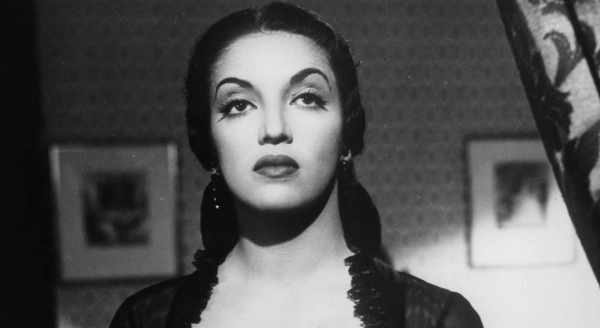
Alterman: There was something about Mary Ellen that also reminded me of Helen Ramirez (Katy Jurado) in Fred Zinnemann’s High Noon, which might be my favorite Western. I remember filming slightly above Mary Ellen, using shallow depth to only focus on her expression – her eyes and lips. In High Noon, I loved how Jurado was so expressionistic with her eyes and movements and how she was filmed in an overly dramatic way. Like Jurado, she was self-aware of this dramatization, so together, collaboratively, we made this scene work.
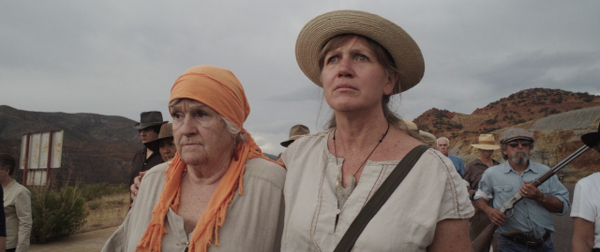
Greene: As we were staging images of a miners’ strike and its bitter aftermath, it was inevitable that we thought of social realist films like John Sayles’ Matewan, Ken Loach’s The Wind that Shakes the Barley or even The Salt of the Earth. The subjects became actors who imagined these films when they walk across a shutdown Highway 80, past the giant manmade wound in the earth called the Lavender Pit, reenacting the tragic march of Bisbee Deportation. These films became our imagined memories and fused with our experiences. Seeing these images sent back to us helped us fathom our collective fantasies.
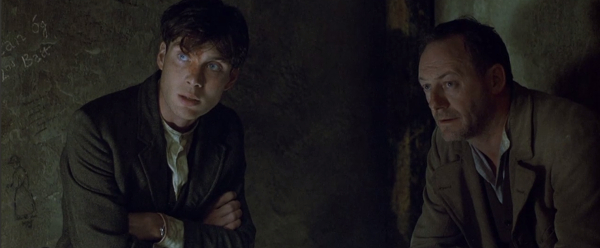
Alterman: I referenced The Wind That Shakes the Barley throughout the entire process of making Bisbee. What I love about the above frame is that it echoes the ideology of the very movement its capturing – these people and their homes, their land and their country are one in the same.
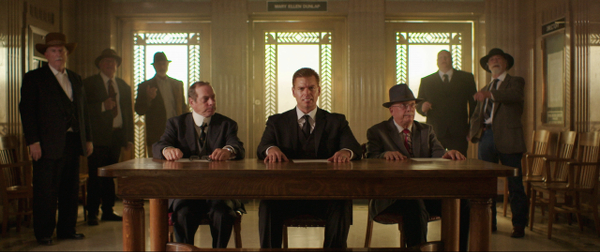
Greene: Seemingly straight-laced County Attorney Britt Hanson was tentatively planning to write and produce a campy musical about the Bisbee Deportation when we first met him. The musical was never staged, but one of the songs he wrote became the basis for this scene where the mine bosses declare their opposition to the strike … and then break into song. Staging theatrical performances in public spaces has long been a strategy for labor movements, but what happens when the bosses are allowed to project their own fantasies?
Bedusa: During the last weeks of pre-production when we were getting ready to move out to Bisbee for the summer, we still only had half our production budget secured. Having worked together for so many years, the question wasn’t if we were going to go, it was how. It’s never easy to speak to directors about budget issues, but I called Robert and told him we were going to have to cut some of the scripted scenes. Not surprisingly, he flat-out refused. Needless to say, this was a challenging day, but it also was one of the most productive: it forced us producers to think creatively about how we could make these scenes happen with the resources we had, and it forced Robert to clearly verbalize his ideas in a way that he hadn’t before. The scripted scenes were going to come out of the documentary scenes; they were the same thing, happening at the same time.
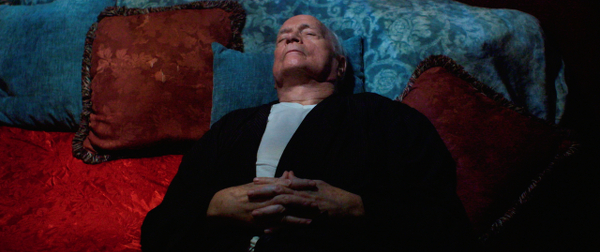
Greene: Former mine boss Dick Graeme agreed to portray Walter Douglas, the mastermind of the Bisbee Deportation, a man he admires greatly. Our plan was to dress up the Bisbee Community Chorus as ghosts in the haunted Copper Queen Hotel and have them sing I.W.W. songs to Dick-as-Walter, to see how he’d react. We knew the results would be surreal, so we dressed the scene like A Christmas Carol by way of Twin Peaks. What resulted is a strange, spooky mix of documentary interview and fantastical illusion. The chains of history rattle with every word.
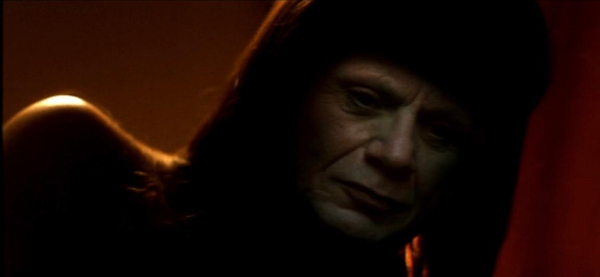
Alterman: We wanted to create a vibe in the room that felt like you’d walked into an art installation – a living set piece from a David Lynch film. We first covered the walls and bed with saturated fabrics and curtains, bathed in deep reds and majestic blues. I wanted to tap into what Lynch and cinematographer Peter Demming did for Lost Highway. For most of the scene, Dick was in shadow, but when he laid back it took on this ghostly quality.
Tirola: Dick’s life is indisputably the sort of thing people talk about when they discuss the American Dream. He started working in the mines cleaning railroad tracks underground and ended up as president of the company, so it’s no surprise that he sees things proudly from the company point of view. When we went to interview Dick in his Tucson home, he had created a 45-minute PowerPoint explaining why he thought that what the company did with the deportation was right.
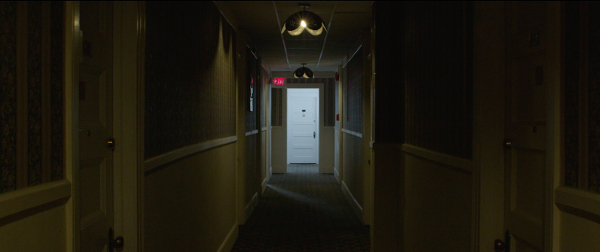
Greene: Ghosts legitimately exist in Bisbee in a few ways. First, there are actual pockets of energy permeating the interior and exterior spaces, electrons from the unearthed minerals bouncing all around. You can feel them, just like you can feel a lightning storm approaching. Ghosts also exist because places like the Copper Queen Hotel, seen in the image above, need them to exist in order to attract tourists. When the mines closed in 1975, the ghosts decided to collaborate with the locals to give travelers a few shows a night, and you can read all about these appearances in the ghost-story logbook at the Copper Queen’s front desk. Our crew stayed there and even had some experiences themselves. These halls were once populated with wealthy guests of the mine bosses, but maybe the miners’ apparitions have scared them all away?
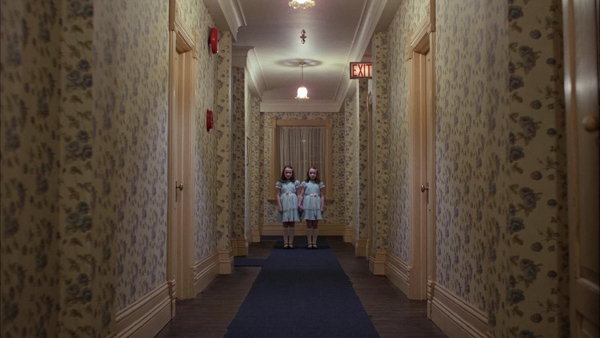
Alterman: One of the genres we wanted to work with was the ghost story. We had to start with the most iconic hallway shot in any ghost story, this unforgettable image from Stanley Kubrick’s The Shining. But after experimenting with too much light, too much fog, I explored the matter-of-factness of the space. Instead of lighting, I took away light. Instead of the door glowing, it now looked flat. The hallway was muddy, noisy and green. We effectively created the inverse of the famous image.
Tirola: The Copper Queen Hotel feels like a building on a Hollywood studio lot. Every detail of the hallways, the lobby, the bar, the rooms is speaking to you, trying to tell you a story. I stayed there off and on for the year we were making the film, and always tried to request the same room to give myself a sense of continuity. When that room was not available, I would stay in the “John Wayne suite.” As legend has it, John Wayne stayed there a little bit bigger than some; much of the room is filled with John Wayne memorabilia giving the space a sort of Vegas-by-a-flicker-on-a-commemorative-plate-of-the Duke-on-cable-TV-in-the-middle-of-the-night feel. From a production standpoint, I always think it’s important to give business to the places you are asking to shoot.
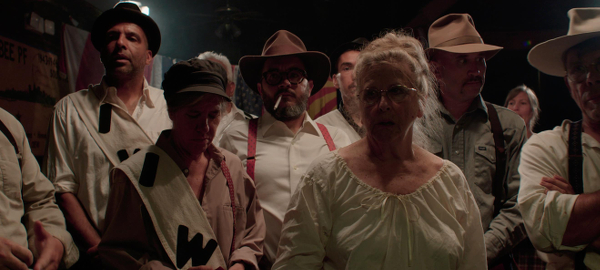
Greene: Ultimately, Bisbee ’17 is a film about a town putting on a show, a collaborative expression of our feelings and ideas about what this dark moment from 100 years ago means to us today, memories collapsing into movie images, dreams becoming performances in the street. The I.W.W. was the manifestation of an anarcho-syndicalist reverie; the bosses of this company town, a municipality existing only because of the magical minerals in its hills, were themselves enacting a grand capitalist dream. On July 12, 1917, these diametrically opposed fantasies met in conflict. The mythologies were used to divide the people, as they are being used today. Let us stare at these facades until our eyes burn through them.
The above is based on a conversation entitled “Mining Bisbee ‘17: A Conversation with Robert Greene and Jarred Alterman” held at the Museum of the Moving Image on September 1, 2018



